Springfield IL & Niemann Foods Don’t Understand Pedestrian-Friendly Design
Recently a reader in Springfield IL, the Illinois state capital 90 miles from St. Louis, alerted me to a new County Market grocery store about to open on the NW edge of their downtown. A local newspaper article talked about the 11,000+ residents within a mile of downtown Springfield and 68,000+ within 5 miles. Tom Moore, director of the new store, was quoted:
“All day long, they come in and say, ‘When are you going to open?’” said Moore. “With the hospitals close by and the apartments close by, we’re expecting quite a bit of foot traffic here. “We’re targeting the whole downtown area, whether it’s the medical community or the neighborhoods.” (State Journal-Register)
Great, they recognize there are many people in the area and they expected lots of foot traffic. Memorial Medical is 2/10th of a mile to the north and St. John’s Hospital is a half mile directly east. County Market is a 100-store chain operated by Niemann Foods based in Quincy IL, an affiliate of Supervalu. Supervalu is the parent company of St. Louis-based chains Save-A-Lot and Shop ‘N Save. More on the new market later. Springfield’s Regional/Urban Design Assistance Team (R\UDAT) report from 2002 speaks briefly to making downtown pedestrian-friendly:
As a neighborhood, downtown Springfield should offer a pedestrian friendly environment with pleasant streetscapes, welcoming crosswalks, green space, or other “softscape” areas, parallel or diagonal parking as a buffer from vehicular traffic, adequate signage and easy to understand “way-finding” systems for visitors. The “way-finding” system should be easy to use, but should be somewhat unobtrusive in keeping with the neighborhood environment. Although the linkages are not yet established, the contiguous districts of commercial and historical importance in Springfield – the Lincoln home, the Capitol District – are very walkable from the central downtown core. A visitor will find it convenient to park in downtown Springfield and walk to these and other nearby attractions. Such programs as Lincoln Walks to Work and Looking for Lincoln will reinforce this walk-ability and contribute to the linkages between the downtown and the Lincoln home neighborhood. (Downtown as a Neighborhood)
In that same section they recognized the need to for additional retail to serve local needs, including a grocery store:
The retail mix should meet the needs of the downtown residents, the downtown employees, the residents in the neighborhoods surrounding downtown and downtown visitors and tourists. This mix should include coffee shops, gourmet retail and take out, bookstores, general grocery and merchandise, dry cleaners that offer bundle service, souvenir and general gift shops, ice cream, bakery and other service based businesses for residents. Bringing these uses into the downtown depends on achieving a larger resident population and the resulting greater purchasing power.
The Springfield Strategy 2020 report, completed in 2010, certainly says all the right things speaks more to making Springfield pedestrian-friendly:
“The Springfield of 2020 has preserved residential neighborhoods surrounding the downtown, which boosts pedestrian traffic in the downtown historic district and acts as a buffer to protect the downtown core.” (p23) “We believe that an effective transportation system must also include facilities to encourage biking and pedestrian traffic.” (p27) “The Springfield of 2020 will be pedestrian friendly with sidewalks being maintained, constructed and reconstructed when necessary throughout the city. This is but one way that the Springfield of 2020 will be know as a city that stresses better accessibility for all of its citizens. In addition, requirements for new subdivisions will be developed to encourage the development of amenities for walking and bicycling, as well as additional green space in all new subdivisions.” (p27) “The Springfield of 2020 will include bike paths downtown that have been sponsored and built by the city to encourage biking to area businesses and work places. The city will also develop new pedestrian walkways to encourage pedestrian traffic to historic and government sites so as to reduce downtown vehicular traffic and increase tourist use of area businesses.” (p27)
Great, Springfield seemed to know what was needed to achieve their objectives. Or not… The new County Market that’s expecting lots of pedestrians opened on March 8th, I visited on the 21st.
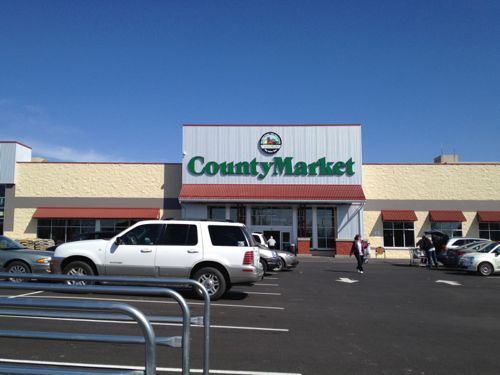
Remember, they’re expecting lots of foot traffic to this store. But 2nd Street is a minor road, Carpenter Street is a main arterial. But access is no better from that new public sidewalk.
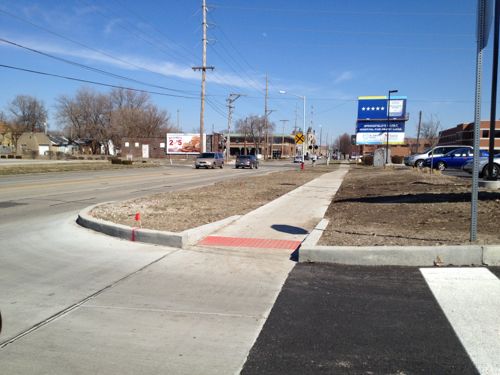
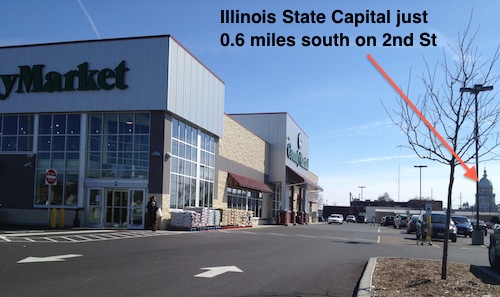
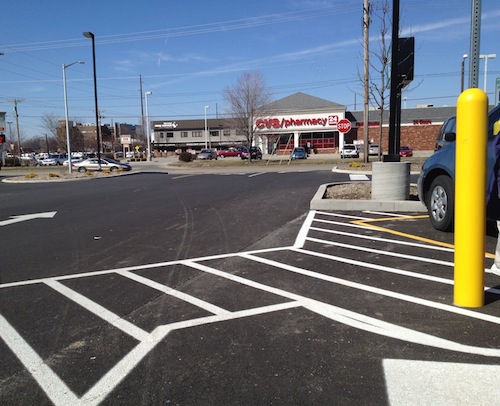
Again, they’re expecting lots of foot traffic yet they’ve made zero provisions for all these pedestrians to reach the store. Like so many places, the pedestrians will be forced to compete with the cars.
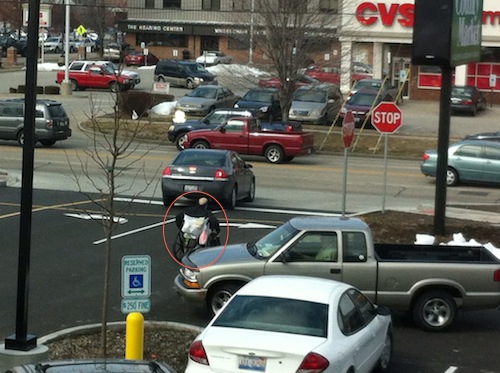
Springfield wants to be pedestrian-friendly by 2020, but they allow this to happen? They also assembled the land and did a $2 million dollar TIF!
Planning and Economic Development Director Mike Farmer hopes it will act as a catalyst for further business growth near the city’s downtown and medical district.
Niemann Foods says 110 full and part-time staff have been hired from the area. The store’s floor plan and design has been called more “urban” than most County Market locations.
The smaller store features a coffee shop with drive-through window and upstairs lounge/dining area with free wireless internet access. A similar store has been built in the heart of the University of Illinois’ Champaign-Urbana campus. (WUIS)
The County Market location at 331 E Stoughton St, Champaign, IL (Google Maps) has the same look, two entrances, and an upstairs — unfortunately that’s where the similarities end. Champaign’s corner entrance is on a different corner and placed at the intersection, while the main entrance faces a surface parking lot.
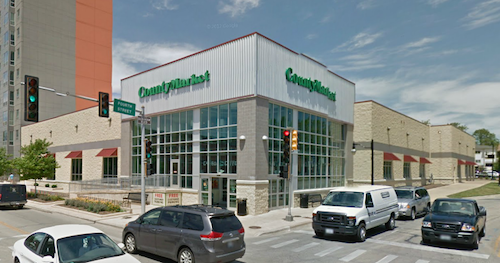
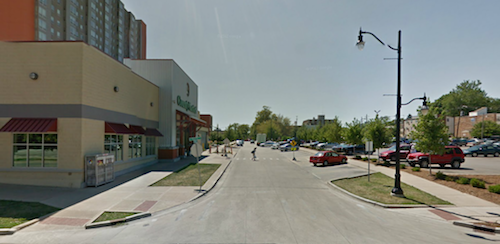
The Champaign County Foods store lacks the two drive-through windows of Springfield — one for coffee and one for pharmacy. I’m pretty sure drive-through service windows decrease pedestrian traffic, not increase it.
Springfield & Niemann Foods had a chance to build a good urban prototype that would’ve been equally accessible by pedestrians and motorists, but they blew it big time. They need to at least provide an ADA Pedestrian Route from both Carpenter and 2nd Streets to each entrance.
Municipalities and businesses in the St. Louis region make the same mistakes too often.
– Steve Patterson
Agree, completely, on the “should” part. The question is how to best get from “should” to “it’s as big of a priority as the drive-thru”? Part of it is there are usually few consequences – permits get issued on flawed plans, certificates of occupancy are approved and affected users don’t sue – and part of it is pedestrians follow fewer rules than vehicles – it’s like herding cats, peds walk wherever they want, usually following the shortest path, while vehicles live much ordered lives that are easier to design for. The other big challenge is that you don’t want to share, you want a separate, segregated, dedicated, equal (or superior) entry sequence, even though pedestrians (especially those with disabilities) currently make up a tiny portion of most businesses’ customer base. Retailers cater to the center of their demographics – Victoria’s Secret doesn’t offer much that appeals (directly) to either one of us – should they be “forced” to offer more stuff we might want? It’s that old chicken-or-egg problem – until there are more pedestrians, their needs will continue to be secondary. (And just adding more and better pedestrian facilities to single-story retail boxes facing surface parking lots won’t generate any more pedestrian [or cycling] customers.)
Obviously this is an auto-centric non-urban cheap commercial development. It was badly done because, well, it was easiest to do it, that’s the default way to build things in the US, and nobody in Springfield pushed them to do it differently. You see the better designed grocery store in Champaign because that’s a much more politically-active city. People actually show up to meetings and push for pedestrian/bike/transit access in addition to auto-access. Democracy is not a spectator sport people!
It’s too late to make this a good urban building short of tearing it down and starting over. They can, however, make it accessible to pedestrians/cyclists for exceedingly cheap: stripe a walkway from the store entryway to the sidewalk that isn’t treacherous and bolt down some bike racks. That’s all that Steve is pushing for.
Google earth is outdated on this because this lot is showing as a run down house and a large field surrounded by many, many parking lots and industrial buildings/offices. The homes start behind the CVS which are separated by rail tracks. But it sure looks like the city is investing in sidewalks. But who wants to walk by office buildings and across parking lots when it’s easier to drive?
Google Earth can’t be that far outdated due to the fact that this County Market JUST opened last month!!!